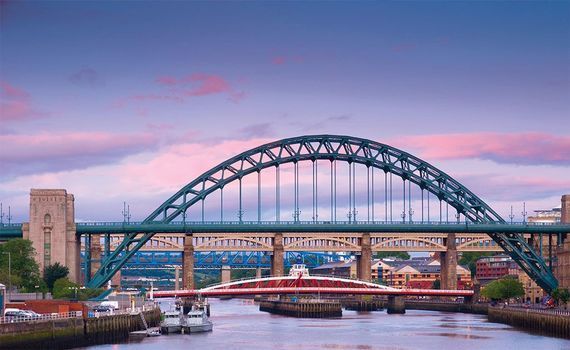
NewcastleGetty: Images
Energetic and amiable, Newcastle upon Tyne is the metropolitan heartland of England’s northeast
Sunshine can be frustratingly rare in Newcastle. Crowds gather to take advantage of its appearance across the river in Gateshead for festivities outside the Baltic Centre for Contemporary Art
Read more
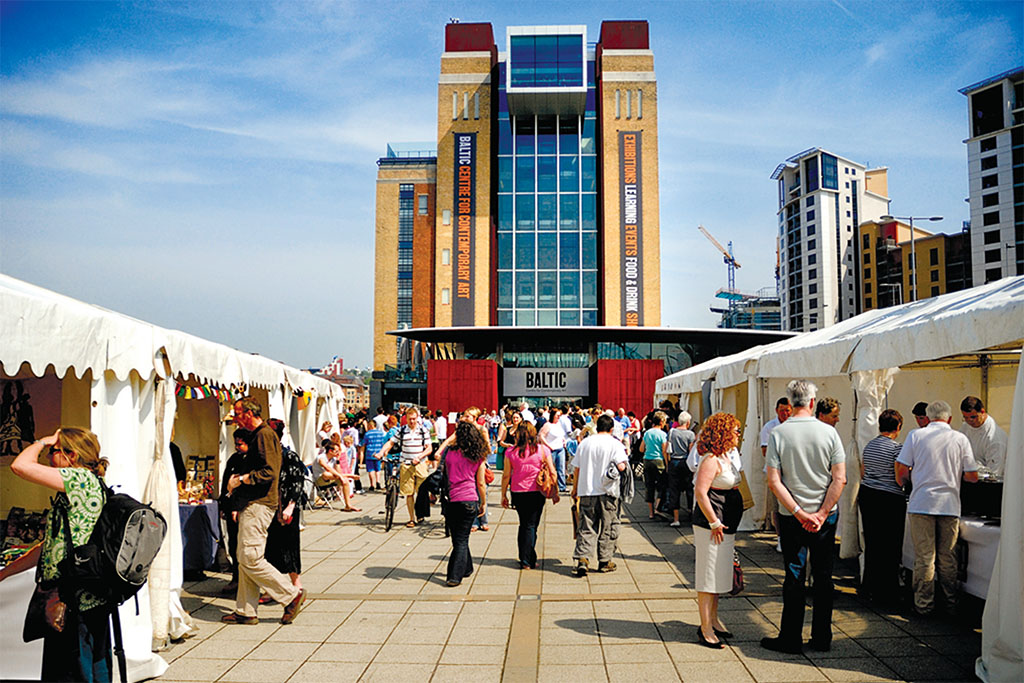
Why go to Newcastle?
Newcastle upon Tyne, 300 miles north of London, is not on the usual tourist itinerary. As a result, visitors miss experiencing this fine Northumbria city with its medieval castle, some beautiful streets and buildings and iconic bridges spanning the historic River Tyne. While the area surrounding the city has been hit hard in recent years as a result of the economic downturn, Newcastle itself, once an industrial center for coal exports and ship building, has reinvented itself in and today is a vibrant, thriving city known for its cultural institutions.
How to get to there
Trains from London’s King Cross station take about three hours including a quick change at Newcastle station for the nine-minute journey to Newcastle Central Metro, the heart of the city. For schedules and current fare prices, visit www.nationalrail.co.uk. If traveling by rail, watch for the popular Angel of the North, a rust-colored steel sculpture created by Antony Gormley in 1998. It is the largest work of art in England and is about eight miles from the center of Newcastle. It can be seen from the right-hand side of the train traveling north from London.
Where to stay overnight
The Vermont Hotel offers an ideal location on Quayside, with reasonable prices and frequent special offers. This independent hotel has views of the castle, which is just next door, from some rooms and views of the Tyne and Millennium Bridges from others. www.vermont-hotel.com Other accommodation options, and a plethora of information about Newcastle’s attractions and events can be found at www.visitnewcastlegateshead.com.
How to spend a day
With just one day, it’s best to concentrate on Grainger Town and Quayside, two principal neighborhoods of the city with in walking distance of each other. If time allows, visit Gateshead, on the south bank of the River Tyne just across from Quayside.
Grainger Town is the geographical heart of the city and contains many of England’s finest neoclassical buildings and streets. Grey Street, which many believe is one of Britain’s architecturally grandest streets, curves beautifully downhill toward the river. The street is dominated by Grey’s Monument, erected in 1838 and topped with a statue of Lord Grey, a local man who was prime minister from 1830 to 1834. The Cathedral Church of St. Nicholas has some interesting medieval stained glass and a superb lantern tower. Stop into the Laing Art Gallery, which is home to an impressive number of major 18th- and 19th-century paintings and sculptures. www.twmuseums.org.uk/laing
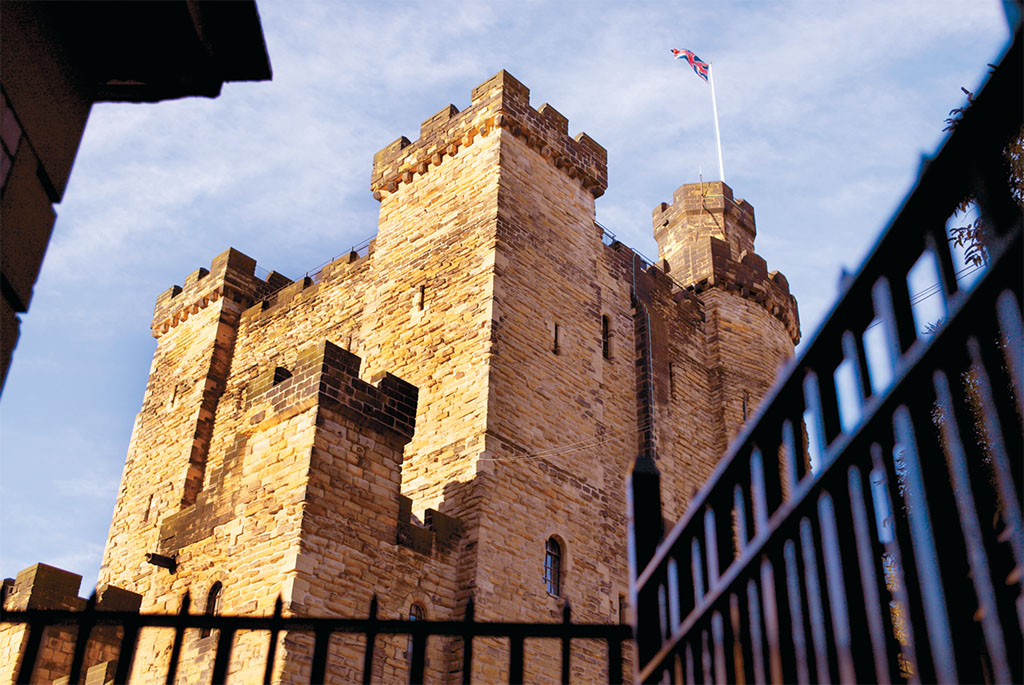
NEWCASTLE GATESHEAD LIBRARY
In the Quayside area, you can see outstanding views of all the bridges spanning the River Tyne. These include the High Level Bridge, the oldest of the existing structures, opened in 1849; the Swing Bridge, opened in 1976; the 1928 Tyne Bridge and the graceful Gateshead Millennium Bridge, which was opened in 2001 and is solely for pedestrians and cyclists. Standing regally above Quayside, the impressive Castle Keep was constructed during the reign of Henry II between 1168 and 1178 to defend Newcastle against Scotland. Today, this stunning building offers an interesting museum and a rooftop with outstanding views across the Tyne. www.castlekeep-newcastle.org.uk
At the top of a flight of stone steps just above the waterfront is All Saints Church, which was deconsecrated in the 1960s, but is open to the public and used today for offices. Built at the end of the 18th century, its spire, not part of the original structure, is a city landmark. Visit Bessie Surtee’s House, the site of a notorious elopement back in 1772, to see its Jacobean façade and interesting interior.
Walk over the Millennium Bridge to the Baltic Centre for Contemporary Art in Gateshead, housed in a reconstructed grain mill dating to 1950. The center is known for its frequently changing exhibitions of contemporary art from around the world. www.balticmill.com
‘Newcastle has reinvented itself in recent years and today is a vibrant and thriving city known for its cultural institutions’
Where to eat
Two suggestions come readily to mind in Grainger Town. Secco at 86 Pilgrim Street offers very good Italian food at reasonable prices. www.seccouk.com The medieval dining room of Blackfriars Restaurant on Monk Street is the oldest in the United Kingdom and makes for a lovely atmospheric meal break. www.blackfriarsrestaurant.co.uk On Quayside, award-winning Café 21 at Trinity Gardens is one of Newcastle’s finest restaurants, and its three-course early bird menu offers exceptional value. www.cafetwentyone.co.uk
For a spot of afternoon tea or coffee, stroll over to Tyneside Coffee Rooms on the second floor of 10 Pilgrim Street and Blake’s Coffee House at 53 Grey Street. Close to the Grey Monument, both of these establishments are very popular with locals and make great choices for afternoon refreshments for visitors.
What to shop for
Football is huge in Newcastle, and visiting fans might want to pick up a few local souvenirs. Eldon Square is a major destination for shoppers; the recently created St. Andrew’s Mall with 1.4 million square feet of retail space is located there, along with branches of England’s major department stores.
Adjoining the square is Eldon Garden with many independent shops, including The Pen Shop, which opened its doors as a stationery store called T & G Allen in 1858. The Pen Shop is now a national chain devoted to writing instruments, but its flagship shop remains in Newcastle. www.penshop.co.uk
Richard Sinton, established in Newcastle in 1984 and also located on Eldon Garden, is well known for the contemporary and classic jewelry it sells. www.richardsintonjewellers.co.uk
Music lovers might stop in to Windows at Central Arcade, in business since 1908, to wander around through three floors of music-related products, ranging from guitars and pianos to CDs and sheet music. www.jgwindows.com
Grainger Market, which is open Mondays through Saturdays, is a fine example of a covered market. It contains numerous stalls, including one that is called the Marks & Spencer Original Penny Bazaar—the world’s smallest branch of the iconic UK department store.
‘Football is huge in Newcastle, and Newcastle United, the local Premier League team, is greatly revered in the North’
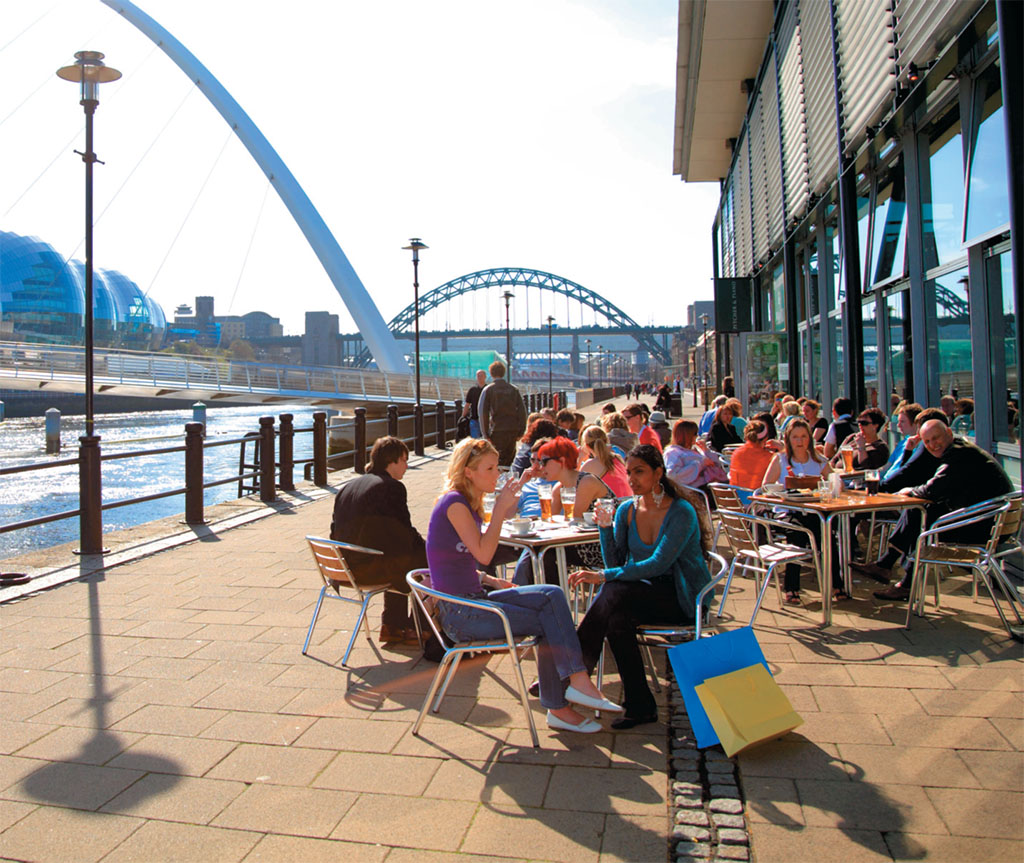
NEWCASTLE GATESHEAD LIBRARY
How to spend the evening
Even those not interested in theater should try to attend a performance at the Theatre Royal in the heart of Grainger Town. The exquisite Palladian entrance offers entry to visiting productions from many of Britain’s finest theater groups, including the Royal Shakespeare Company and the National Theatre. This theater, one of England’s most famous, was built in 1837 and reconstructed in 1901 after a devastating fire. www.theatreroyal.co.uk
Designed by the well-known architect Norman Foster, the Sage Gateshead at St. Mary’s Square on the waterfront in Gateshead, just across the River Tyne, is a unique landmark and a venue for live musical performances. It is well worth the time to explore this building,which Anthony Sargent, its general director, describes as “sweeping glass and steel designs, which perfectly mirror the inspiring vastnesses of the sea and sky which define our region.” www.thesagegateshead.org
Or if you are just looking for a relaxing evening out, enjoy one of Newcastle’s many pubs such as one of the city’s oldest, The Old George, located at Cloth Market.
Neat to know about Newcastle
Newcastle is known to its local population as “the Toon,” because the local dialect, a heavy regional accent called “Geordie,” pronounces the word “town” as “toon.” Newcastle United, the Premier League football team greatly revered here in the north, is called “the Toon army”.
In the vicinity
From Newcastle, it is easy striking distance up the Northumbrian coast to visit Alnwick, home of the majestic Alnwick Castle, and the Holy Island of Lindisfarne—but be sure to check out the tide tables as the island is only accessible at low tide.
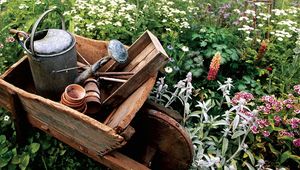
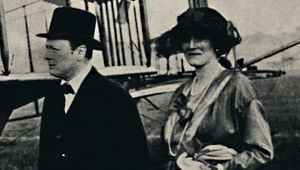



Comments